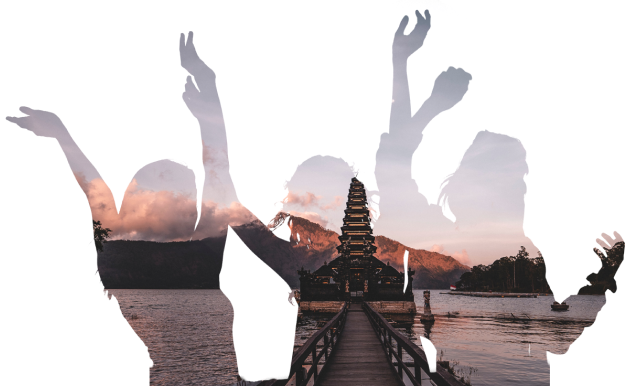
5 Must-Visit Temples in Bali
In addition to the island's numerous lovely beaches, breathtaking waterfalls, and traditional villages, Bali's temples rank among the most intriguing and significant tourist attractions on this tiny Indonesian island. Bali has some of the most unique and beautiful temples in the world.
While you may come to the island to relax and enjoy the sunlight, you'll quickly discover that visiting Bali's top temples is also a lot of fun.
A visit to the temples is a fantastic opportunity to learn more about Balinese life and culture because they are such a significant part of it. Additionally, some of Bali's top temples are just breathtaking. A trip to Bali is complete if at least one of the temples is visited.
Today we combine several must-visit temples in Bali that should be included in your itinerary whenever you visit the island of Gods on your holiday.
Besakih Temple
The Bali Besakih Temple, also known as Pura Besakih by the locals, is Bali's largest Hindu temple. Visitors from across the world frequently visit this temple because of its stunning view from the top of the temple area, where we can see the expansive natural landscape to the open sea. Besakih Temple is situated east of the island's Karangasem regency, in the Besakih countryside, Rendang subdistrict. It is situated in the southwest corner of Bali's tallest mountain, Mount Agung. Besakih temple is also gained popularity due to its position since Mount Agung is well known to be the holiest Mount on the island.
Besakih Temple, the "mother temple" of Bali, is located well over 900 meters up Gunung Agung's slopes. Since prehistoric times, Bali has revered this location as a sacred site. An inscription from 1007 A.D. is the first time its presence has been officially acknowledged. It has been recognized as the island's main, sacred temple since the Gelgel dynasty in the fourteenth century.
At Besakih, the Balinese people's many allegiances converge. Within the overall complex, every caste and regency has its temples.
Tanah Lot Temple
Tanah Lot is often cited as the embodiment of Bali's romance. Tanah Lot, which translates to "Land in the Sea," is the ideal moniker for its distinctive offshore surroundings. The silhouette of Pura Tanah Lot is one of Bali's most well-known landmarks.
Picture a Balinese temple or Pura positioned high on a rock overlooking the vast ocean. With the sound of the waves breaking below and the magnificent hues of the sunset lighting up the background, only 30 kilometres separate Tanah Lot from Denpasar, which is in Tabanan.
Bhatara Segara, also known as the sea God, is the subject of the Tanah Lot temple. With great power, he conjured a venomous snake from his belt to guard the shrine. It is said that the sea serpent resides at the bottom of this rocky island to protect the temple from nefarious visitors.
The entrance to Tanah Lot is lined with art businesses selling local handicrafts in addition to
other iconic local goods because it is one of Bali's most photographed sea temples today.
Odalan, observed every 210 days, is the ideal time to visit Tanah Lot. On the holy day known as Buddha Cemeng Langkir, the rites often occur close to the Galungan and Kuningan celebrations. On this day, you will observe rows of Balinese ladies praying at the Tanah Lot temple while eloquently bearing offerings on their heads. Tanah Lot's tourism sector, next to the rock, is excellently run for visitors. It features a parking space, restrooms, art galleries, restaurants, a hotel, an open stage, a tourist information centre, and security and safety services.
Taman Ayun Temple
This temple, situated in Mengwi, Badung, outside the busy city centre and about 18 kilometres (or 8 miles) northwest of Denpasar, is surrounded by beautiful flora and ponds. Bali's Taman Ayun Temple is one of the best in terms of beauty and popularity. Only the king and queen may enter this work of art from the 17th century, which was constructed as a family temple for the Mengwi Empire. Given its highly robust and intricate architectural design, UNESCO has designated this temple as a World Cultural Tourism Site.
The four courts that make up the Taman Ayun Temple complex span an area of 100 x 250 m2. The first one is referred to as "Jaba", or the outer court, with just one entry through a bridge across the ponds. A vast "wantilan" hall and a modest guardian shrine can be found in the first inner court, frequently used for community events.
The second inner court will then greet you with a towering fountain and a large shelter decorated with features and reliefs showing the nine Gods guarding the cardinal directions. In conclusion, the complex's third inner court, which is also its highest, is regarded as its most sacred location. The elaborately adorned gate, also known as the "gelung door" or the Utama Mandala, is only opened for specific rituals and is known as the Utama Mandala.
The name Taman Ayun, which means "A Beautiful Garden," accurately describes the temple's surroundings, which include several tier-shrine complexes devoted to various gods, a gorgeous garden filled with well-maintained vegetation, a thatched-roofed prayer house, and canals. It's understandable why this is the top location where people go to find tranquillity.
Ulun Danu Beratan Temple
The magnificent Ulun Danu Temple is located on a terrace overlooking Lake Beratan in Bali's highlands of the hilly Bedugul Regency. Around 1,500 meters above sea level, in the pleasant mountain climate, the air is crisp and refreshing. Except for a gentle wind that passes through sometimes and causes a few little ripples on the surface of the sparkling lake, it is peaceful and nearly wholly still. The temple is surrounded by a fine mist that rises from the lake and hovers in the air, giving it a slightly strange look.
In honour of the goddess Danu, Pura Ulun Danu was constructed. The Balinese word for lake is Danu, and the Goddess Danu is the ruler of all bodies of water, including rivers and lakes. Four revered structures make up the temple complex. Shiva's temple, Linga Pura, is three storeys tall. The 11-story Pura Puncak Mangu was constructed as a temple for the deity Vishnu. The primary temple is Pura Teratai Bang, while Pura Dalem Purwa was constructed as a place of devotion for Sang Hyang Widhi. Individuals who pray for fertility, prosperity, and well-being visit this final shrine.
The second-largest lake in Bali, Lake Beratan, provides irrigation for plantations and rice fields all over Bedugul Village. It is commonly referred to as "the holy mountain" since the weather is excellent and the land is abundant and fertile. Before a terrible earthquake split Lake Beratan into its three portions, Beratan, Buyan, and Tamblingan, it was once the biggest lake in Bali. The term "Brata," which means to behave in a way that satisfies the nine fundamental demands of existence, is the root of the name "Beratan." The phrase "Tapa Brata," which means to contemplate and be one with nature, contains the word.
Saraswati Temple
Pura Taman Saraswati, a stunning water temple with a sizable pond overflowing with pink lotus flowers, is located in the centre of Ubud. Dewi Saraswati, the Goddess of knowledge and the arts, is the source of the temple's name (the same one as in Gunung Kawi Sebatu Temple).
Saraswati, the Hindu goddess of knowledge, writing, and the arts, is revered in the Kingdom of Ubud. Many people visit this temple for religious purposes, but it is also lovely and artistic, drawing large crowds. The focal point of Pura Taman Saraswati's appeal as a tourist destination is a water garden and lotus pond. The Padmasana shrine within this temple is ornamented with several exquisite carvings. It also has bale barong, enormous masks, sculptures of the goddess Saraswati, and a three-meter-tall figure of the devil Jero Gede Mecaling in front of the temple.
The Balinese commemorate Saraswati Day, honouring the wisdom God bestowed via the lovely Dewi Saraswati every six months. We heartily encourage you to visit this temple while you're in Ubud due to its convenient location, free admittance (during the day), and simple accessibility.
Uluwatu Temple
Hindu cliff-top temple Uluwatu Temple is located in the southern portion of the Bali Peninsula. Additionally, it is one of Bali's Sad Kahyangan Temples (six big groups of Bali Temples). This temple is 25 kilometres south of Denpasar town in Pecatu Village, a subdistrict of South Kuta, Badung Regency. Eighty meters above sea level, the temple is perched on a coral reef exposed to the sea. Locals refer to the little dry woodland that Uluwatu Temple has as Alas Kekeran (interdict forest).
Along with other species like birth, this woodland is also home to three groups of monkeys. The words Ulu and Watu are the origin of the name Uluwatu. Ulu refers to the head and Watu to the stone. Uluwatu Temple refers to the temple constructed near the coral reef's edge.
Two boat-shaped stone managers are on the right and left sides of the temple structure. When both managers are combined, it resembles a coffin, a renowned megalithic stone. Additionally, there is a 16th-century archaeological omission in the form of a winged entry gate or an arch. One of the rare archaeological exclusions is the winged entry gate. Furthermore, the Uluwatu Temple's winged entry gate may be likened to the identical one seen in the mosque complex in Sendang Duwur Village in the Lamongan Region of East Java around the same era of construction.
As your best travel buddy, we are ready to accommodate you and make this one a trip that you will remember for a long time. Let us know if you have any questions. Contact us here



